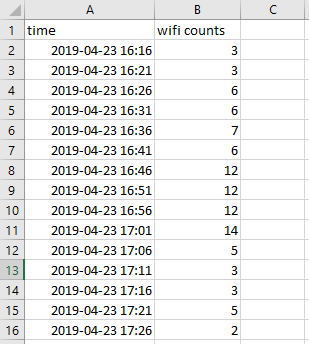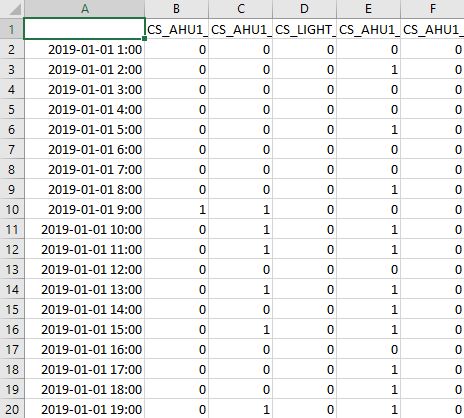Occupancy
The occupancy function generates daily occupant count profiles and calculates typical occupant arrival and departure times.
Inputs
Wi-Fi Device Count
The occupancy function can input Wi-Fi device count data. These data count the number of actively recognized, but not necessarily connected, devices by a building's Wi-Fi access points. The function uses device count data as a proxy for occupant count by equating 1.2 devices per occupant. These data should be formatted in a spreadsheet seen in Figure 1 below.

The first column should contain the timestamp at which the device count is measured. The timestamp must include the numerical date and time and in the following format: [yyyy-mm-dd hh-mm]. The second column should contain the number of devices recognized by a Wi-Fi access point. This column should only contain whole numbers (i.e., 2.4 is not an acceptable entry).
A minimum of one (1) CSV file containing Wi-Fi device count data for the whole building can be supplied to this function. However, if there is greater certainty amounting in floor-level device count data (i.e., you have device count data for each floor of the building), you may input several CSV files whereby each file contains the data pertaining to a different floor. If the function recognizes that more than one CSV file is provided, floor-level occupant count profiles will be generated. See outputs for information about generated KPIs and visuals.
Motion Detection
Alternatively, the occupancy function can input motion detection data instead of Wi-Fi device count data. Though the same function, inputting motion detection data will not yield the occupant count profiles as it would with Wi-Fi device count data; key performance indicators will also vary. See outputs for motion detection data for more information. Motion detection data should be formatted as in the example spreadsheet seen in Figure 2 below.

Like Wi-Fi device count data, the first column should contain the timestamp, which must include the numerical date and time and in the following format: [yyyy-mm-dd hh-mm]. Each subsequent column should represent one instance of a motion detection sensor and contain either a zero (0), indicating no presence detected, or a one (1), indicating presence detected.
Only one (1) CSV file containing motion detection data can be supplied to this function.